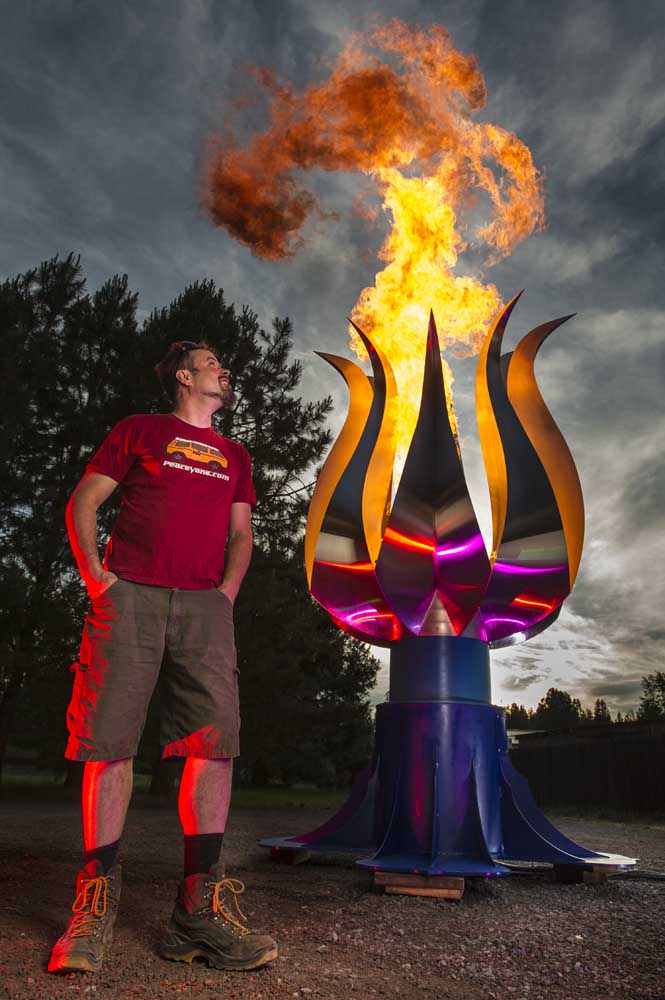Q&A with artist Miguel Edwards
Published 12:00 am Thursday, June 28, 2018

- Local artist Miguel Edwards stands next to the sculpture he created for the Special Olympics opening ceremony in Seattle in July. (Ryan Brennecke/Bulletin photo)
Who: Miguel Edwards is a sculptor and photographer who moved to Bend from Seattle in March. His Deschutes River Woods workshop overlooks a wooded area replete with deer and marmots. “The quality of life in Seattle is not what it was,” he told GO! “It’s nice to finally be here.” Edwards recently completed a large cauldron over 13 feet in height, to be lighted for the 2018 Special Olympics USA Games, taking place Sunday through July 6 in Seattle. For more on Edwards, as well as photos of his incredible large-scale steel and kinetic sculptures, visit migueledwards.com.
Q: How did you get tapped to do the cauldron?
A: (Dale) Chihuly, a big glass artist in Seattle — he’s kind of The Rolling Stones of the glass world. … They wanted somebody local to do it, and so they approached his organization. The CFO promptly sent them my way. But it was kind of a twofold thing. … Also, a friend of mine I worked with years ago doing event management and production stuff was working for the Special Olympics production subcontractor. He put my name in the hat, also, and so my name came at them from two directions, and then I had to do a proposal. I think by the time they got to the proposal part of it, they were only looking for a proposal from me.
Q: Did they have something in mind for what they wanted, or did you pitch what you wanted to see if it stuck?
A: They asked if it could be inspired by their logo, which actually, as logos go, is pretty cool. It’s kind of an elemental thing. It’s a teardrop shape with some fire elements to it. … The teardrop shape is such an enclosed thing that you wouldn’t be able to see the fire at all. I made a bunch of paper models and my collaborator, Ray Freeman, who’s sort of my draftsman and architect … he and I get a lot accomplished quickly. He’s in Seattle, so he actually came down and we had a day and a half and just hammered through a bunch of stuff. … It was neat, because we were making these paper models, and then we built this one, compressed it and flipped it inside out, and it was like, “Oh, great, it’s awesome. Now, how do you make it out of steel?” (Edwards and Freeman then began a process moving back and forth between computer-aided drafting, other software and paper models for adjustments, etc.) There were multiple generations — at least six generations of paper, then we went to steel about 18 inches tall. … The first full-size steel was a fail, and then we added some material and stuff. I think we made a total of five steel tendrils … all plasma-cut by hand, and then packed together, and worked out the geometry one more level, then made a couple of more adjustments, then committed to stainless (steel), because it was a pretty tight turnaround.
Q: How much time did you have?
A: The Instagram post of May 6 was “here’s this paper model.” I think on June 7, I posted an assembled cauldron. I worked on the project longer than that, but as far as how long it took to actually build it, it was a month and a day. We’re still doing touch-up.
Q: How high do the flames shoot?
A: Pretty much as high as we want. (Laughs) For the normal burn, they’re 3 to 6 feet.
Q: What becomes of the cauldron after the Special Olympics?
A: Well, it is available for purchase. I told them I would try to place it regionally, Puget Sound area. … For a final resting place, we would convert it to natural gas instead of propane, which would be a super-easy thing to do. It burns a little cleaner, and it’s a safer gas.
— David Jasper, The Bulletin






